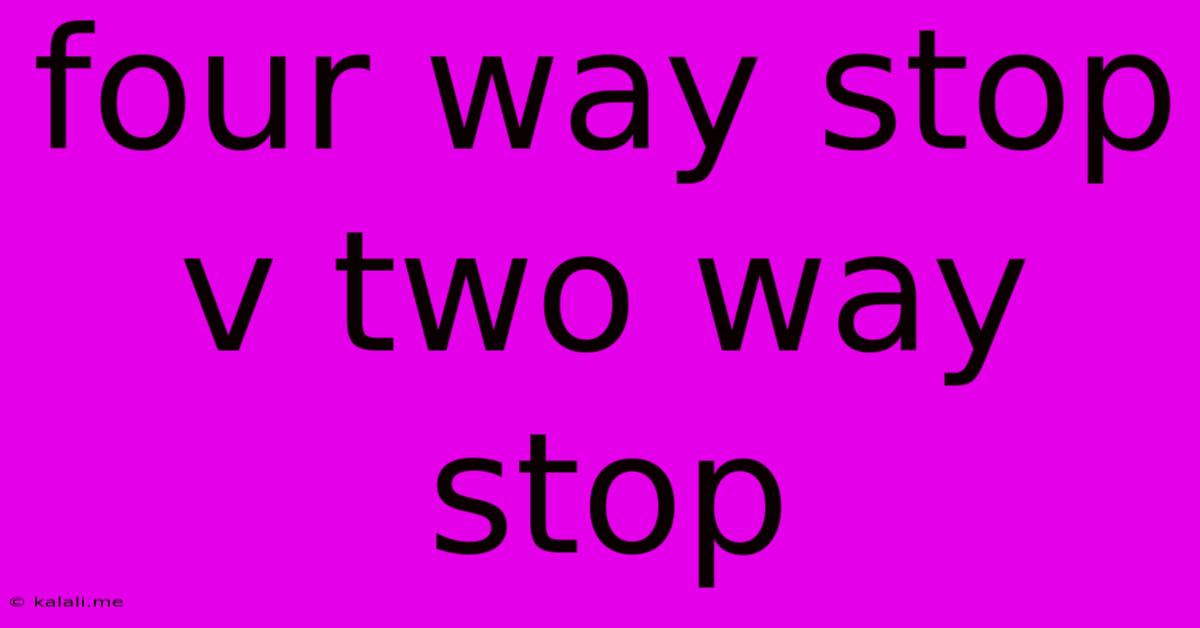Four Way Stop V Two Way Stop
Kalali
Jun 06, 2025 · 3 min read

Table of Contents
Four-Way Stop vs. Two-Way Stop: Understanding the Differences and Staying Safe
Navigating intersections can be tricky, especially when dealing with stop signs. Understanding the nuances between a four-way stop and a two-way stop is crucial for safe driving. This article will break down the key differences, explain the rules of each, and offer tips to help you navigate these situations confidently and safely.
What is a Four-Way Stop?
A four-way stop, as the name suggests, involves stop signs on all four approaches to an intersection. This means drivers on all intersecting roads must come to a complete stop before proceeding. This setup is commonly used at intersections where there is equal or nearly equal traffic flow from all directions, or where visibility is limited, requiring drivers to yield to each other.
Rules of the Road at a Four-Way Stop:
- First Come, First Served: The first vehicle to arrive at the intersection has the right-of-way.
- Simultaneous Arrival: If two or more vehicles arrive at the intersection simultaneously, the vehicle to the right has the right-of-way.
- Yield to the Right: Even if you arrive first, you must yield to any vehicles already stopped on your right.
- Complete Stop: A complete stop means your vehicle comes to a full and complete halt. Rolling stops are illegal and dangerous.
- Observe and Proceed Safely: After coming to a complete stop, you must yield to any traffic that still has the right of way before proceeding. Carefully observe your surroundings before proceeding.
What is a Two-Way Stop?
A two-way stop only has stop signs on two opposing approaches to the intersection. Traffic on the roads with stop signs must come to a complete stop before yielding to cross-traffic. Traffic on the roads without stop signs typically has the right-of-way, unless otherwise indicated. This is a common setup on roads with higher traffic volume on one road and lesser on the intersecting road(s).
Rules of the Road at a Two-Way Stop:
- Stop Sign Obedience: Vehicles approaching the intersection from the roads with stop signs must come to a complete stop.
- Yield to Cross-Traffic: After stopping, drivers must yield to all cross-traffic that is approaching the intersection and has the right-of-way.
- Priority to Through Traffic: Traffic on the roads without stop signs has the right-of-way, but they must still drive cautiously and be prepared to stop if necessary.
- Complete Stop Required: As with four-way stops, rolling stops are illegal and unsafe.
- Clear View Before Proceeding: Before proceeding, drivers must ensure they have a clear and unobstructed view before entering the intersection.
Key Differences Summarized:
| Feature | Four-Way Stop | Two-Way Stop |
|---|---|---|
| Stop Signs | Four approaches | Two opposing approaches |
| Right-of-Way | First come, first served; right-of-way to the right | Through traffic usually has the right-of-way |
| Traffic Flow | Typically balanced traffic flow | Uneven traffic flow |
| Complexity | More complex to navigate | Relatively simpler to navigate |
Tips for Safe Navigation:
- Reduce Speed: Approach all intersections slowly and cautiously, whether it's a four-way or two-way stop.
- Check Mirrors: Regularly check your mirrors to monitor approaching traffic.
- Use Signals: Signal your intentions clearly before entering the intersection.
- Be Patient: Remain patient and yield to other drivers as needed.
- Be Aware of Cyclists and Pedestrians: Always be mindful of cyclists and pedestrians, especially at intersections.
Understanding the differences between four-way and two-way stops is crucial for safe and efficient driving. By following these rules and tips, you can contribute to a safer driving environment for everyone. Remember, respecting the rules of the road is not only a legal obligation but also a responsible and essential element of safe driving practices.
Latest Posts
Latest Posts
-
How To Tile A Shower Niche
Jun 07, 2025
-
Toilet Bubbles When Flushed But Not Clogged
Jun 07, 2025
-
When To Use Gear 1 And 2 In Automatic
Jun 07, 2025
-
Rebellion Is A Sin Of Witchcraft
Jun 07, 2025
-
How To Check Affinity Fallout 4
Jun 07, 2025
Related Post
Thank you for visiting our website which covers about Four Way Stop V Two Way Stop . We hope the information provided has been useful to you. Feel free to contact us if you have any questions or need further assistance. See you next time and don't miss to bookmark.